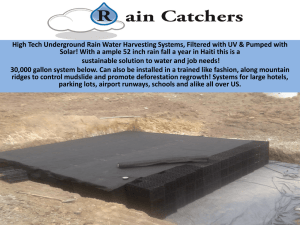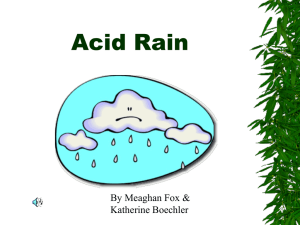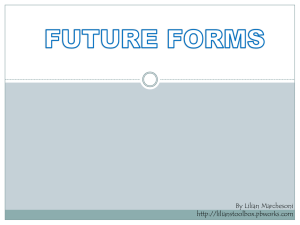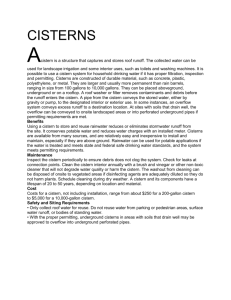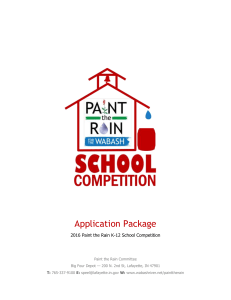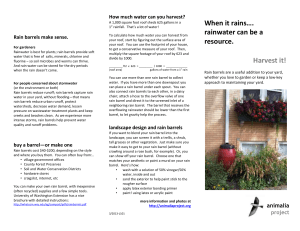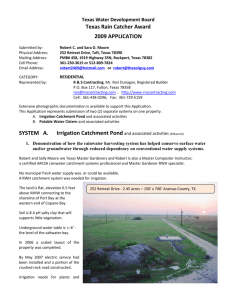Cost - Water Resources Action Project
advertisement
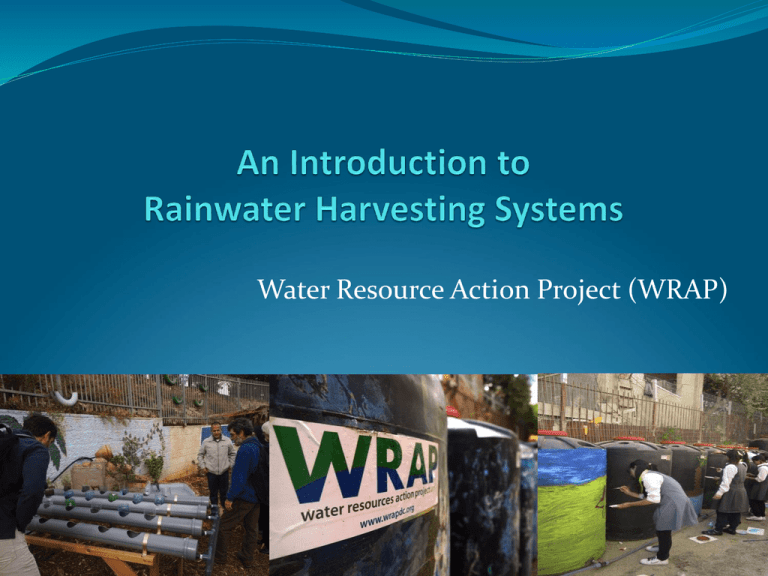
Water Resource Action Project (WRAP) Why Rainwater Harvesting Systems? For You, the Middle East, and the Environment Alternative source of water – Reduced reliance on conventional water supply systems such as lakes, rivers, underground aquifers, bottled and desalinated water. Monthly reporting through 2.5 rainy seasons showed on average 70% of Sur Baher Girls School’s total water usage supplied by rain barrel system. Saves money – Conventional supplies of water are often costly, especially when water resources are scarce. Schools in Israel spend tens of thousands of shekels on water annually. Rain harvesting systems can save up to two thirds of this cost. Why Rainwater Harvesting Systems? For You, the Middle East, and the Environment Relatively easy/inexpensive to construct – Costs of implementation, construction, and maintenance for rainwater harvest systems are often recovered within a few years. An environmental choice – Preserves water resources that are quickly diminishing in the Middle East. It also reduces the millions of plastic bottles used every day. Proven technology – Simple, proven tool that provides for the schools’ water needs Components of Harvesting System Catchment Area • Rooftop • Land surface Collection Device • Storage tanks • Rain barrel • Water cistern Conveyance System • Gutters • Down-pipes • Pumps Catchment Area Rooftop o Amount of water collected dependent on surface area and type of roofing o Usable material: galvanized corrugated iron, aluminum, asbestos cement sheets, tiles and slates o Avoid metallic paint or other coatings that are hazardous to health o Water is collected in gutters and carried to storage Land surface o Often has larger surface area for collecting water o Requires techniques to improve runoff capacity Clearing or altering vegetation cover Increasing the slope of the land Soil compaction Reducing soil permeability with chemicals Conveyance System Rain Gutters - collect water from catchment area Down-pipes - transport water from catchment area to collection devises Down-pipe flap - help to prevent debris from entering collection devises Submersible pump - pump water from storage tank to storage barrels Collection System: Style One Rain Barrels Material: polyethylene Volume: 1,520L Cost: recovered in few years Quality of water: high Space requirement: minimal Maintenance: easy Sediment collection: little (all sediment is collected in the first barrel) Supply: Can supply 7-10 days of water depending on use Use: shorter periods between rains, situations in which rain is not the sole source of water Basic Schematic of Rain Barrel System Submersible pump starts pumping water from underground storage tanks to storage barrels when underground storage tank is ¾ full and shuts down when it is less than ½ full. Gutters Rooftop Catchment Area Underground storage tank (100L) Storage barrels (1520L) Water is piped from storage directly into the school. Collection System: Style Two Cistern Material: primarily concrete with epoxy coating and bituminous on walls Volume: 62,000L Cost: recovered in several years Quality of water: medium to low Space requirement: large Maintenance: difficult Sediment collection: large (up to a foot of mud can accumulate on the bottom every year) Supply: Can supply water during longer periods of drought Use: summer/ long periods between rains/ situations in which rain is the sole source of water Basic Schematic of Cistern System Gutters Rooftop Catchment Area Submersible pump transports water from the cistern directly into the school. Cistern (62,000L) Water is piped from storage directly into the school. Sur Baher Girls School and Al-Afaq School for Special Education WRAP constructed a rain barrel system for both schools, located in East Jerusalem Before Both schools faced costly and unreliable municipal water After Monthly reporting through 2.5 rainy seasons show on average 70% of Sur Baher’s total water usage supplied by system Reduced water bills and provided greater understanding of water’s value, importance of conservation Recognizing the rain barrel system as a tool used to meet the needs of the school Cost vs. Benefit – Rain Barrel System Item Benefits Cheaper to implement than a water cistern Cost recovered in a few years Ensures more high quality water Minimal space requirement Fairly easy to design, construct, and maintain Does not require a special permit to implement Little sediment collection Can be refilled 20-30 times during rainy season Cost 8 Rain storage barrels (1,520L easy flush tank)/stand 3,520 3 Rain collection units (100L with submersible pump) 900 Pump w/ pressure valve & parts (piping, faucets, fittings) 1,990 Pumphouse (protects from vandalism and electrification) 250 sub-total $6,660 Labor & Maintenance Installation, planning, & design by licensed contractor 3,650 Routine maintenance (3 yr) 860 sub-total $4,510 Oversight Ongoing monthly reporting, annual oversight visits (3 yr), education & routine maintenance coordination 3600 sub-total $3,600 Education & Community Outreach In school project educator, includes training & ongoing supervision (3 yr) 6,900 sub-total $6,900 Total Poject Cost $21,670 Battir Girls High School WRAP constructed a cistern for the Battir Girls High School, located in the West Bank Before The Battir Girls High School bathrooms closed as a result of insufficient water supplies and unsanitary conditions After The school can: Keep its bathrooms open Host a summer camp Implement a community garden Cost vs. Benefits – Cistern Benefits Stores large amounts of water over long periods of time without rain Durable – lasts for long time periods Best used for summer time with long periods between rains Best used when rain is the sole supply of water Item Cost Plastering the cistern walls (internally & externally) 1,120 Epoxy coating/bituminous on walls 560 sub-total $1,680 Labor & Maintenance Excavation & removal of surplus material 1,800 Supply & construction of reinforced concrete for cistern base, walls, & roof 11,000 Supply & installation of water pump, one horse power Supply & installation of rain gutters Routine maintenance (3 years) sub-total Education & Community Outreach Project educator, included training and ongoing supervision (3 years) sub-total Total Project Cost 1,500 2,020 860 $17,180 6,900 $6,900 $25,760 Thank You! How to Support WRAP Spread the Word Tell others about the issues, solutions, and WRAP Feedback We welcome it! Join Us Become a Member / Own a Project (Start to Finish) Stay in Touch Email – info@wrapdc.org Website – www.wrapdc.org Like Us on Facebook – www.facebook.com/wrapdc Follow Us Twitter – @WRAP_DC
